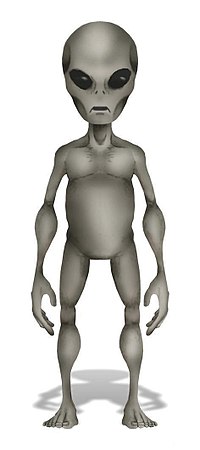Goā-chheⁿ jîn
Guā-tsheñ-jîn (guā-tsheñ tì-huī sing-bu̍t, guā-tsheñ-lâng, ú-tiū-jîn, ú-tiū-lâng, thài-khong pîng-iú; eng-gí: extraterrestrial intelligence (ETI); hàn-gí: 外星人, 宇宙人, 太空朋友), khah-tsá kiò-tsò (title) ú-tiū-jîn (宇宙人), sī jîn-luī tuì tē-kiû í-guā ê tì-huī sèñ-miā tsi thóng-tshing (title). Tsū kóo-tsá kàu tsit-má, jîn-luī tuì kî-thañ ê hîng-tsheñ kám ū tshûn-tsāi (existence) guā-tsheñ-jîn, í-ki̍p guā-tsheñ-jîn kap i-ê bûn-bîng sī siáñ-mih, it-ti̍t teh ioh, siūñ, gián-kiù (research) kap thàm-soh (Discovery (observation)).[1]Tsi̍t-kuá lâng kah tē-piáu tíng-kuân phái-iōng kho-ha̍k kái-sueh ê bûn-bîng sán-bu̍t iá-sī UFO, lóng-tsóng kóng-sī guā-tsheñ-jîn kah in-ê íng-hióng.[2]M̄-koh tsit-má tē-piáu tíng-kuân ê bûn-bîng in-uī ū tsi̍p-thé (collective) ì-sik kap pîn-lu̍t ê kuan-hē iá-koh bô-huat-tōo si̍t-tsè thàm-tsa m̄-tsai kám ū guā-tsheñ-jîn bô, sīm-tsì m̄ tsai kám ū guā-tsheñ sèñ-miā ê tshûn-tsāi.[3]


Ū tsi̍t-kuá ha̍k-su̍t (academic discipline, academic field) tan-uī (work unit) (kî-tiong khah ū-miâ ê pau-kuah Harvard tāi-ha̍k, Ka-tsiu tāi-ha̍k, Berkely (University of California, Berkeley) kap hui îng-lī tsoo-tsit SETI hia̍p-huē tíng-tíng) mā-ū tsham-ú soo-tsa tē-guā bûn-bîng kè-uē (SETI). Tsia-e̊ tsoo-tsit tì-li̍k teh iōng siā-tēn tiàu-kiàñ (radio telescope) tsit-khuán sen-tsìn ê set-pī tsiap-siu uì ú-tiū tiong thuân-lâi ê tiān-tsû pho; khah uì lāi-té hun-sik ū kui-lu̍t ê sìn-hō, hi-bāng (hope) tsioh-tshú huat-hēn guā-tsheñ sèñ-miā.[4][5][6]
Voyager 1 tâi-gí sio-tsioh-mn̄g
siu-káiVoyager 1 (voyager 1) sī tsi̍t tsiah bô-lâng guā thài-iông-hē thài-khong ê thàm-tshik-khì (space probe). Teh 1997 nî 9 gue̍h tshe 5 huat-siā, tsia̍t-tsì kàu 2021-nî koh-teh ūn-tsok. Voyager 1 tíng-kuân tsah tsi̍t tiuñ tâng-tsit ê kim khik-puâñ, lāi-iông pau-kuah iōng 55 tsióng lîn-luī (человечество) gí-gên lo̍k-tsè ê sio-tsioh-mn̄g kap kok-luī im-ga̍k, lāi-iông tsú-iàu sī beh kah guā-tsheñ-jîn piáu-ta̍t lîn-luī siān-ì ê sio-tsioh-mn̄g. Khik-puâñ ū 12 inch kāu, tōo-kim piáu-bīn, lāi-té ū khǹg tshiùñ-ki (phonograph) tsiam. Kî-tiong pau-kuah tâi-gí ê sio-tsioh-mn̄g (greeting): Thài-khong pîng-iú, lín hó! Lín tsia̍h-pá bē? Ū-îng, tō-lâi gún-tsia tsē-o̊h.[7]
| Tâi-lô jī | Hàn-jī (Tâi-gí hàn-jī) | Eng-gí | Gí-im tóng(NASA Voyager 1 bāng-ia̍h) |
|---|---|---|---|
| Thài-khong pîng-iú, lín hó! Lín tsia̍h-pá bē? Ū-îng, tō-lâi gún-tsia tsē-o̊h. | 太空朋友,恁好!恁食飽未?有閒著來阮遮坐喔。 | Friends of space, how are you all! Have you eaten yet? Drop in on us if you are available. |
Tsù-kái
siu-kái- ↑ Plurality of Worlds: The Extraterrestrial life Debate from Democritus to Kant, by Steven Dick, Cambridge University Press 1984 (Eng-gí)
- ↑ The Extraterrestrial Life Debate: 1750-1900, by Michael J. Crowe, Dover Publications, 2011 (Eng-gí)
- ↑ Are we alone? Peter Spinks. May 21, 2013. (Eng-gí)
- ↑ University of Nottingham (15 June 2020). "Research sheds new light on intelligent life existing across the galaxy". EurekAlert!. goân-loē-iông tī 2021-05-27 hőng khó͘-pih. 15 June 2020 khòaⁿ--ê. (Eng-gí)
- ↑ University of Nottingham (15 June 2020). "Research sheds new light on intelligent life existing across the galaxy". Phys.org. 15 June 2020 khòaⁿ--ê. (Eng-gí)
- ↑ Westby, Tom; Conselice, Christopher J. (5 June 2020). "The Astrobiological Copernican Weak and Strong Limits for Intelligent Life". The Astrophysical Journal. 896 (1). arXiv:2004.03968 . doi:10.3847/1538-4357/ab8225. 15 June 2020 khòaⁿ--ê. (Eng-gí)
- ↑ Voyager-The Interstellar Mission,"Voyager - Languages"[1] Archived 2017-01-31 at the Wayback Machine.,JPL/CIT,August 20, 2010.
Tsham-khó bûn-hèn
siu-kái- 江晃榮博士. 不可思議外星人神祕檔案. ISBN 978-986-6722-51-6. (Hàn-gí)
- 蘇言、徐剛著.UFO最新真相.江蘇人民出版社.2011年4月 (Hàn-gí)
- 飛碟探索雜誌社編著.飛碟探索30年.朝華出版社.2011年9月 (Hàn-gí)
- 吉姆·馬爾斯著.外星人已潛伏地球5000年.鳳凰出版社.2011年8月 (Hàn-gí)
- Michael Ashkenazi: What we know about extraterrestrial intelligence. Springer, Cham 2017, ISBN 978-3-319-44455-0 (Tek-gú)
- Daniel Gerritzen: Erst-Kontakt - warum wir uns auf Außerirdische vorbereiten müssen. Kosmos, Stuttgart 2016, ISBN 978-3-440-14871-6. (Tek-gú)
- Ernst Fasan: Discovery of ETI - Terrestrial and extraterrestrial legal implications. Acta Astronautica, Vol.21, Issue 2, February 1990, S. 131–135. (Tek-gú)
- George Basalla: Civilized life in the universe - scientists on intelligent extraterrestrials. Oxford University Press, New York 2006, ISBN 0-19-517181-0. (Tek-gú)
- Peter Ulmschneider: Intelligent life in the universe - principles and requirements behind its emergence. Springer, Berlin 2006, ISBN 978-3-540-32836-0. (Tek-gú)
Ên-sin ua̍t-to̍k
siu-kái- Roth, Christopher F., "Ufology as Anthropology: Race, Extraterrestrials, and the Occult." In E.T. Culture: Anthropology in Outerspaces, ed. by Debbora Battaglia. Durham, N.C.: Duke University Press, 2005. (Eng-gí)
- Sagan, Carl. 1996. The Demon-Haunted World: Science as a Candle in the Dark: chapter 4: "Aliens" (Eng-gí)
Tsham-ua̍t
siu-kái- Hui-hêng bô͘-gí-khì (hui-hîng bôo-gí-khì; eng-gí: flight simulator; hàn-gí: 飛行模擬器)
- Gîn-khòng khai-chhái (Gîn-khòng khai-tshái/Silver mining)
- Bô-miâ-sì (2021 tiān-iáⁿ) (Nobody (2021 film))
- He̍k bú-khì tong-liōng (Hi̍k bú-khì tong-liōng/Nuclear weapon yield (yield of a nuclear weapon))
- Mathematics Genealogy Project (Sòo-ha̍k póo-hē kè-uē/Mathematics Genealogy Project)
Guā-pōo lên-ket
siu-kái- 台灣飛碟學會 (Taiwan UFOlogy Society) (Hàn-gí)
- SETI@Home (Eng-gí)